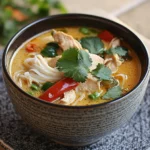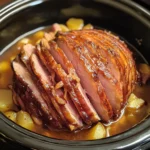Description: This recipe showcases the delicate flavor of salmon, enhanced by a bright and herbaceous lemon-dill sauce. The simple preparation method allows the quality of the ingredients to shine, resulting in a healthy and delicious meal that’s perfect for a weeknight dinner or a special occasion.
Why You Will Love This Recipe:
- Quick & Easy: From start to finish, this dish comes together in under 30 minutes.
- Healthy & Delicious: Salmon is packed with omega-3 fatty acids and protein, making it a nutritious and satisfying choice.
- Versatile: The lemon-dill flavor profile pairs well with a variety of side dishes, offering endless possibilities for customization.
- Impressive Presentation: The bright colors and fragrant aroma of this dish are sure to impress your family and guests.
- Flavorful and balanced: The zing of the lemon, the fresh dill, and the richness of the salmon create a symphony of flavors that will leave you wanting more.
Introduction
Salmon with lemon and dill is a classic combination for good reason. The bright, citrusy notes of lemon perfectly complement the richness of salmon, while the fresh, herbaceous flavor of dill adds another layer of complexity. This recipe is not just about combining ingredients; it’s about creating a harmonious balance of flavors that elevates the natural goodness of the salmon.
This recipe takes the traditional pairing and streamlines it for the modern home cook. By using a simple baking method, you can achieve perfectly cooked salmon with minimal effort. The lemon-dill sauce is whisked together in minutes and brushed over the fillets, infusing them with flavor as they bake. The addition of lemon slices on top not only adds visual appeal but also further intensifies the citrusy aroma.
Whether you are a seasoned chef or a beginner in the kitchen, this recipe is accessible and rewarding. It’s a fantastic way to incorporate more seafood into your diet and discover the joys of cooking with fresh, seasonal ingredients.
Ingredients:
- 4 salmon fillets (about 6 oz each): Choose skin-on or skinless fillets depending on your preference. Skin-on fillets will be slightly more moist and flavorful. Look for fillets that are firm, vibrant in color, and free of any fishy odor.
- 2 tablespoons olive oil: Use a good quality extra virgin olive oil for the best flavor.
- 2 tablespoons fresh lemon juice: Freshly squeezed lemon juice is essential for the bright, citrusy flavor. Bottled lemon juice can be used in a pinch, but it won’t have the same depth of flavor.
- 1 teaspoon lemon zest: Lemon zest adds a concentrated burst of lemon flavor. Be sure to zest only the yellow part of the lemon, as the white pith underneath can be bitter.
- 2 cloves garlic, minced: Garlic adds a savory note to the sauce. Use fresh garlic for the best flavor. Mince the garlic finely to ensure it distributes evenly throughout the sauce.
- 1 teaspoon Dijon mustard: Dijon mustard adds a tangy and slightly spicy element to the sauce. It also helps to emulsify the oil and lemon juice, creating a smoother consistency.
- 1 teaspoon honey (optional): Honey adds a touch of sweetness to balance the acidity of the lemon juice. If you prefer a less sweet flavor, you can omit the honey.
- 2 tablespoons fresh dill, chopped: Fresh dill is crucial for the herbaceous flavor of this dish. Dried dill can be used in a pinch, but it won’t have the same vibrant flavor.
- Salt and pepper to taste: Season the salmon fillets generously with salt and pepper to enhance their natural flavor.
- Lemon slices for garnish: Lemon slices add a decorative touch and intensify the citrusy aroma.
Preparation:
Step 1: Preheat the oven to 400°F (200°C). Line a baking sheet with parchment paper or lightly grease it. Preheating the oven ensures that the salmon will cook evenly. Parchment paper prevents the salmon from sticking to the baking sheet and makes cleanup easier. Alternatively, you can lightly grease the baking sheet with olive oil or cooking spray.
Step 2: In a small bowl, whisk together the olive oil, lemon juice, lemon zest, garlic, Dijon mustard, honey (optional), and fresh dill. Whisking the ingredients together ensures that they are well combined and emulsified. The Dijon mustard helps to bind the oil and lemon juice together, creating a smoother and more cohesive sauce. The honey adds a touch of sweetness, balancing the acidity of the lemon juice.
Step 3: Place the salmon fillets on the prepared baking sheet and season with salt and pepper. Arrange the salmon fillets in a single layer on the baking sheet, leaving some space between them to allow for even cooking. Season the fillets generously with salt and pepper, both on top and underneath. This will enhance the natural flavor of the salmon and ensure that the dish is well-seasoned.
Step 4: Brush the lemon-dill mixture evenly over the salmon fillets. Use a pastry brush or spoon to spread the lemon-dill mixture evenly over the top of each salmon fillet. Make sure to coat the entire surface of the fillet, ensuring that every bite is infused with flavor.
Step 5: Arrange lemon slices on top of the fillets. Place a few thin slices of lemon on top of each salmon fillet. The lemon slices will add a decorative touch and infuse the salmon with even more citrusy aroma.
Step 6: Bake in the preheated oven for 12-15 minutes, or until the salmon flakes easily with a fork. The baking time will vary depending on the thickness of the salmon fillets. Check for doneness by inserting a fork into the thickest part of the fillet. If the salmon flakes easily, it is cooked through. Be careful not to overcook the salmon, as it can become dry and tough.
Step 7: Remove from the oven and let rest for a couple of minutes before serving. Allowing the salmon to rest for a few minutes after baking allows the juices to redistribute, resulting in a more moist and flavorful dish.
Step 8: Serve warm with your favorite side dishes like roasted vegetables, rice, or a fresh salad.
COOKING Rating:
Easy
Serving Suggestions:
- Roasted asparagus or broccoli
- Quinoa or brown rice
- A simple green salad with a lemon vinaigrette
- Mashed sweet potatoes
- Garlic bread
Tips:
- For extra flavor, marinate the salmon fillets in the lemon-dill mixture for at least 30 minutes before baking.
- If you don’t have fresh dill, you can use 1 teaspoon of dried dill, but the flavor won’t be as vibrant.
- To prevent the salmon from sticking to the baking sheet, you can also use a non-stick baking mat.
- If you prefer a crispy top, broil the salmon for the last minute or two of cooking time.
- Leftover salmon can be stored in the refrigerator for up to 3 days.
Prep Time:
10 minutes
Cook Time:
12-15 minutes
Total Time:
22-25 minutes
Nutritional Information:
(Approximate, per serving)
Calories: 350 Protein: 40g Sodium: 200mg
Conclusion
Salmon with lemon and dill is a testament to the power of simple ingredients and techniques. This recipe offers a delightful combination of flavors, a healthy dose of nutrients, and a hassle-free cooking experience. It’s a recipe that you’ll find yourself returning to again and again, whether you’re looking for a quick weeknight meal or a dish to impress your guests.
The versatility of this recipe allows you to customize it to your liking. Feel free to experiment with different herbs, spices, or vegetables to create your own unique variation. The key is to start with high-quality salmon and fresh ingredients, and then let your creativity guide you.
Enjoy the process of cooking and savor the deliciousness of this classic dish!
Questions and Answers about Salmon with Lemon and Dill:
Q1: Can I use frozen salmon for this recipe?
A: Yes, you can definitely use frozen salmon. Be sure to thaw it completely before cooking. The best way to thaw salmon is to place it in the refrigerator overnight. If you’re short on time, you can thaw it in a cold water bath. Place the frozen salmon in a sealed plastic bag and submerge it in a bowl of cold water. Change the water every 30 minutes until the salmon is thawed. Avoid thawing salmon at room temperature, as this can promote bacterial growth.
Q2: What if I don’t have Dijon mustard? Can I substitute it with something else?
A: Absolutely! If you don’t have Dijon mustard on hand, you can substitute it with yellow mustard or even a touch of horseradish for a bit of a kick. Yellow mustard will provide a similar tangy flavor, while horseradish will add a spicier note. Alternatively, you can simply omit the mustard altogether; the recipe will still be delicious, although the sauce might be slightly less emulsified.
Q3: Can I cook the salmon on the grill instead of baking it?
A: Yes, grilling salmon is a fantastic alternative. Preheat your grill to medium-high heat. Lightly oil the grill grates to prevent the salmon from sticking. Place the salmon fillets, skin-side down if using skin-on fillets, on the grill. Cook for 4-6 minutes per side, or until the salmon flakes easily with a fork. Be sure to keep a close eye on the salmon to prevent it from overcooking. Brushing the salmon with the lemon-dill mixture throughout the grilling process will help to keep it moist and flavorful.
Q4: I’m not a fan of dill. What other herbs can I use instead?
A: If dill isn’t your favorite, don’t worry! There are plenty of other herbs that would pair well with salmon and lemon. Consider using fresh parsley, chives, tarragon, or even a combination of herbs. Parsley offers a mild and fresh flavor, chives provide a delicate onion-like taste, and tarragon adds a subtle anise-like note. Experiment with different herbs to find your perfect flavor combination.
Q5: How can I tell if the salmon is cooked through without overcooking it?
A: The key to perfectly cooked salmon is to avoid overcooking it. The best way to check for doneness is to insert a fork into the thickest part of the fillet. If the salmon flakes easily with the fork, it is cooked through. The internal temperature of the salmon should reach 145°F (63°C). You can also tell if the salmon is cooked by observing its color. Cooked salmon will be opaque and slightly firm to the touch, while undercooked salmon will be translucent and soft. Remember that the salmon will continue to cook slightly after you remove it from the oven, so it’s best to err on the side of slightly undercooked rather than overcooked.




